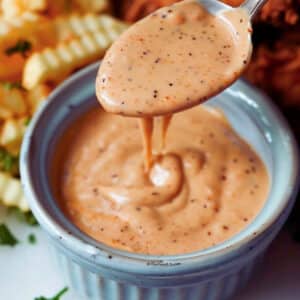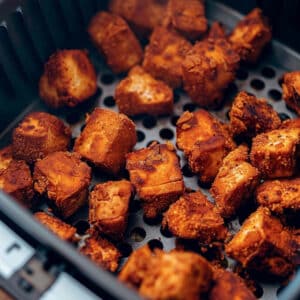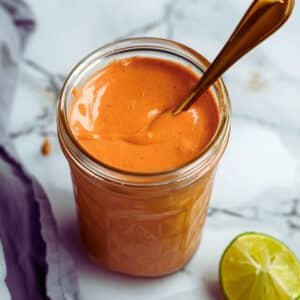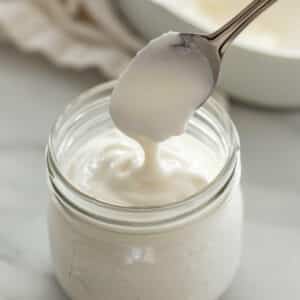I've spent a weekend of love and dedication bringing you this stunning Char Siu Pork recipe. The best part? Most of the preparation involves letting the pork marinate, leaving you with plenty of time to relax.
Now, imagine biting into a warm, fluffy, steamed bao bun filled with that sticky, mouth-watering char siu pork paired with a crisp pickle or spicy kimchi. Trust me; it's a flavor explosion worth every minute of the marination time.
I love serving this Char Siu Pork with fluffy jasmine rice and some stir-fried Asian greens or a crunchy Asian slaw. And, if you're in the mood for a steaming bowl of Ramen noodle broth, it's the perfect addition to your meal.
But let's be real, sometimes the best way to enjoy this savory pork is to pick at it straight from the fridge with your fingers whenever the craving strikes.
Take Aways
- Proper Brining: Brining the pork before marinating is crucial to enhance the flavor and tenderness of the meat.
- Dry Surface, Prick and Marinate: Drying the surface of the pork and pricking it helps to maximize the absorption of the marinade, making the Char Siu more flavorful.
- Sous Vide Cooking: Cooking the pork using the sous vide method ensures that the meat is cooked evenly and retains its juicy texture. It also allows for precise temperature control, making it easier to achieve the perfect Char Siu every time.
Get Ready to Experience a Flavor Explosion!
If you're new to Char Siu, let me tell you when it's made to perfection, it's a true balance of tender and juicy, savory and sweet pork flavors.
I'm talking about the umami kicks from ingredients like fermented bean curd, hoisin, and oyster sauce, the zing from the wine, and the sweetness from brown sugar and maltose syrup. Get ready to taste the harmony of these flavors in every bite! And to tie it all together, we've got the magic touch of five spice powder, a staple in Chinese cuisine.
Ingredients you'll need:
As a fan of adding a touch of heat to balance the sweet, sticky marinade, I added Korean red pepper flakes (gochugaru). Not only does it bring a pop of red color, but it also provides a subtle spicy kick. It's important to note that these flakes differ from red chili flakes, which can be too overpowering. If Korean red pepper flakes are unavailable, I recommend adding a pinch of white pepper to achieve a similar flavor profile.
- 900 grams of pork shoulder or butt (sliced into thick 5-7 cm wide strips along the grain)
Brine ingredients:
- 1 liter of water
- ¼ cups salt
- ½ cup sugar
- 2 tablespoon peppercorns
- 2 bay leafs
- ½ onion
- 6 cloves garlic, peeled
For the Marinade:
- 2 tablespoon black treacle, golden syrup, or muscovado sugar
- 1 piece red bean curd (fermented tofu) and 2 tablespoon of the sauce from the tin or jar
- 2 tablespoon [oyster] sauce
- 1 Tbsp Chinese rose wine (or Shaoxing wine)
- 2 tablespoon light soy sauce
- 2 tablespoon ketjap manis or more light soy sauce
- 2 cloves of garlic, peeled and finely chopped
- 1 small shallot, peeled and finely chopped
- a good thumb of fresh ginger, peeled and grated
- 1 teaspoon Chinese five-spice powder
- 2 tablespoon Korean red pepper flakes (optional)
- 1-2 star anise
For the glaze:
- The reserved marinade
- ¼ cup maltose syrup (or honey)
Step by Step directions:
Step 1 It's time to prepare the pork for the brine!
Slice the pork into desired pieces and let it soak in the brine mixture for 8 hours or even overnight. This step will infuse the pork with flavor and ensure a juicy and tender result.
Step 2 Maximizing marinade absorption is key
After brining the pork, we need to dry the outside and prick the surface to ensure the marinade is fully absorbed. Wet surfaces won't allow for efficient absorption, ensuring the pork is dry and ready to soak up all that flavor.
To do this, I prick the surface of the pork and dry it thoroughly with paper towels. This allows the water to evaporate from the surface of the pork, making it a sponge-like surface ready to absorb the marinade. Place the pork on a rack for even better results and let it dry in the fridge for a few hours.
Step 3 Let's get the marinade going!
Over a water bath, mix all the marinade ingredients until the sugar has fully dissolved. Once it has, let it cool and set it aside. This step is crucial in creating the perfect balance of flavors for your Char Siu.
Step 4 It's time to bring the glaze to life!
Drain the marinade from the pork and sieve it into a small saucepan. Add the ¼ cup of maltose syrup (or honey) and get ready to reduce it over medium-low heat for 5 to 8 minutes. Stir occasionally as it thickens, and once it reaches the desired consistency, set it aside.
As the glaze cools, it will become even thicker and more flavorful, taking your Char Siu to the next level of deliciousness. So, be patient and let it reach its full potential. The result will be a sticky and delectable glaze that will leave you wanting more.
Sous vide method:
Step 1 Get ready to seal the flavor in!
We're dividing the pork strips into individual bags and sealing them. If they're not too wet, we'll use the vacuum sealing to lock in all the deliciousness. If not, we'll use a vacuum chamber designed for liquids.
Step 2 Heat the water bath to 63° C.
Set the temperature of your water bath to 63° C and let the sous vide magic happen as you cook the pork strips for 8-10 hours.
To the finishing steps:
Step 1 Take the Char Siu out of the water bath!
Carefully remove the sous vide bags from the bath as the timer goes off. Take the pork out of the bags and give it a good pat down with some paper towels to remove any excess moisture.
Step 2 It's time to move the pork to the next stage!
Transfer the tender and juicy pork to a foil-lined baking dish safe for the broiler. Allow a short break to cool down for 5-10 minutes before applying the sauce. The glaze will set perfectly by allowing the pork to cool and give the Char Siu a gorgeous sheen. Trust me; this step is worth the wait.
Step 3 Now, it's time to bring the Char Siu to life!
Carefully apply the delicious glaze to both sides of the pork. Then, it's time to give it a quick grill in the oven. Place the pork back in the oven and let it grill for 5 minutes on each side or until it develops those mouth-watering charred bits at the edges. This is the final step in creating the perfect Char Siu that is crispy on the outside and juicy on the inside.
Step 4 It's time to serve up your Char Siu masterpiece!
Transfer the succulent pork to a serving plate and give it a well-deserved rest for 5 minutes. Then, get ready to slice it into mouth-watering ¼-inch-thick pieces.
Method #2 Roasting method:
Step 1
It's time to preheat the oven to 145°C (fan force) and get ready to roast some delicious Char Siu.
Step 2
Oil a wire rack over a foil-lined tray. Then, arrange the pork strips on the rack. Pour in ½ cup of water, cover everything with foil, and make sure it's tightly sealed.
Step 3
Pop the tray in the oven and let it roast for 20 minutes. After that, remove the foil and let it roast for an additional 10-15 minutes or so on the other side.
Step 4
The moment of truth has arrived! It's time to take the pork out of the oven, switch to grill mode, and turn up the heat to 250°C. Allow the pork to cool for 5-10 minutes before grilling. This will allow the glaze to set and give the pork a beautiful sheen.
Step 5
Then carefully apply the glaze to both sides of the pork. Then place the pork back in the oven and grill it for 5 minutes on each side or until it develops charred bits at the edges. This is the final step in creating the perfect Char Siu that is crispy on the outside and juicy on the inside.
Pro Tip:
Maximize the juiciness of your Char Siu by adding a tray of water under the meat in the oven. This will create a steam-roast effect that will keep the pork extra moist. Follow Leslie's tip and cover the pork with foil for a more delicious result.
Why use these ingredients:
The ingredients in this Char Siu recipe all play a crucial role in creating a delicious and authentic dish. Here's why each ingredient is essential:
- Pork Shoulder or Butt: This cut of meat is perfect for Char Siu because it has the right balance of fat and muscle to keep the meat juicy and flavorful after cooking.
- Muscovado Sugar (or Coconut Palm Sugar): The sugar in the Brine helps to infuse the pork with a sweet and rich flavor. Using muscovado or coconut palm sugar adds a deeper, molasses-like flavor to the pork.
- Chinese Shaoxing Rice Wine (or Chinese Rose Wine): Rice wine helps to tenderize the pork and adds a subtle depth of flavor. Chinese rose wine, if available, brings a unique floral taste to the dish.
- Rose Water (optional): This ingredient adds a subtle floral fragrance to the pork.
- Black Treacle, Golden Syrup, or Muscovado Sugar: The marinade uses these syrups to add a sweet, sticky glaze to the pork.
- Red Bean Curd: This fermented tofu adds a rich, savory flavor to the marinade.
- Hoisin Sauce: This sweet and salty sauce adds depth and complexity to the marinade.
- Light Soy Sauce: Soy sauce is used to add a salty flavor to the marinade and helps to balance out the sweetness.
- Ketjap Manis: This sweet Indonesian soy sauce is used to add a touch of sweetness to the marinade.
- Garlic: Garlic adds a sharp and pungent flavor to the marinade.
- Shallot: Shallot adds a delicate sweetness and a mild onion flavor to the marinade.
- Ginger: Ginger adds a spicy and warming flavor to the marinade.
- Chinese Five-Spice Powder: This spice blend adds a complex and aromatic flavor to the marinade.
- Korean Red Pepper Flakes (optional): These flakes add a spicy and hot flavor to the marinade.
- Star Anise: Star anise adds a sweet and spicy licorice flavor to the marinade.
- Maltose Syrup (or Honey): This ingredient creates a sticky and sweet glaze for the pork.
Note:
Maltose is a must-have ingredient if you're after that classic lacquered look for your Char Siu Pork. This thick (not very sweet), sticky syrup creates a glossy coating on the pork as it cools down. While you can skip the maltose, the glaze will be more like a sauce that smears when slicing, sacrificing that iconic Char Siu appearance.
Don't worry, the taste will still be delicious, but it won't have that true Char Siu character. While honey can be used as a substitute, it doesn't work as well as maltose to achieve that authentic Char Siu look. You can easily find maltose at any Asian grocery store, major supermarkets, or even on sites like Amazon.
What is Chinese rose wine (Mei Gui Lu Jiu)?
Chinese Rose Wine, also known as méiguī lùjiǔ (玫瑰露酒) in Mandarin, is a type of sorghum liquor that is infused with fresh rose flowers and sugar. The result is a sweet, fragrant liquor with a floral taste and aroma.
Chinese Rose Wine is sometimes compared to a sweet, floral vodka and is considered a unique and essential ingredient in traditional Chinese cuisine. Chinese cooking often uses it to flavor dishes, particularly in marinades and sauces.
Essential aspects of making sous vide char siu
Making sous vide Char Siu at home requires careful attention to several key elements to ensure a delicious and authentic result. Here are the most important aspects to focus on:
- Choosing the Right Cut of Pork: Using a cut of pork with the right balance of fat and muscle, such as the shoulder or butt, is crucial for a juicy and flavorful Char Siu. Use pork shoulder or butt cut into thick 5-7 cm wide strips along the grain.
- Brine the pork: Brining helps to add flavor and tenderize the meat by allowing it to soak in a saltwater solution. When the pork is brined, it absorbs the saltwater solution, and the salt penetrates the meat, breaking down the muscle fibers and making it more tender. Additionally, the salt helps enhance the pork flavor, creating a deeper and more complex taste. This results in a juicier and more flavorful Char Siu that will impress. So, don't skip this step!
- Make the marinade: The marinade comprises a combination of ingredients, including black treacle, hoisin sauce, light soy sauce, garlic, ginger, and Chinese five-spice powder. These ingredients work together to create a delicious and flavorful marinade that will infuse the pork with flavor and moisture.
- Dry and prick the pork: When the surface of the pork is wet, the marinade will not be absorbed easily. This is why drying the surface and pricking the pork before marinating is important. By pricking the surface of the pork, you create small channels that allow the marinade to penetrate the meat more easily. This results in a Char Siu infused with flavor and moisture from the marinade.
- Marinate the pork: When marinated, it has time to absorb the marinade flavors, resulting in a Char Siu packed with flavor. The marinade also helps to tenderize the pork, making it more juicy and tender—Marinate for at least 8 hours or overnight for maximum flavor.
- Cook the pork sous vide: Cook the pork sous vide at a temperature of 140°F (60°C) for 8 hours or until the internal temperature reaches 145°F (63°C).
- Glaze the pork: After cooking, glaze the pork with maltose syrup or honey to give it a glossy, lacquered look.
- Broil the pork: Broil the pork in the oven for 5 minutes on each side or until it develops bits of char at the edges.
Read:
What are the best cuts of pork for char siu?
The best cuts of pork for char siu are typically cuts from the shoulder, such as pork shoulder or pork butt, which have a good balance of fat and meat. This makes them tender, flavorful, and suitable for marinating and grilling.
Other good options include pork belly, a fattier cut that will become incredibly juicy and tender when cooked, or boneless pork loin, which is leaner but still flavorful. Ultimately, the best cut for char siu will depend on personal preference and cooking method.
Should you use red food coloring for cooking char siu?
The use of red food coloring in cooking char siu is a matter of personal preference and cultural tradition. Some people believe the bright red color is a hallmark of traditional char siu and use red food coloring to achieve it. Others prefer using natural ingredients to color their char siu, such as fermented bean curd, hoisin sauce, or red fermented tofu.
What to use instead to get that red color of char siu?
Several natural ingredients can be used to achieve the red color of traditional char siu without using food coloring. Some of the most common ingredients include:
- Fermented bean curd: This salty and savory ingredient can add flavor and color to your char siu marinade.
- Hoisin sauce: A sweet and savory sauce made from soybeans, garlic, and spices. It can also add color and flavor to your char siu.
- Red fermented tofu: This type of tofu is made from soybeans fermented with red yeast, giving it a distinctive red color and tangy flavor.
- Soy sauce: This can add depth of flavor and dark, reddish-brown color to your char siu.
Read:
Pro tips to perfect this recipe:
Tip 1
Many recipes instruct you to add the marinade ingredients to the pork strips, but I strongly advise taking an extra step to make the sauce first over a water bath. This allows you to taste and adjust the marinade to your liking before adding it to the pork.
Your ingredients may differ from mine, so tasting the sauce first is crucial. The marinade should have a balanced, Peking duck sauce-like flavor. If it's too salty, add more sugar. Add a bit more light soy sauce or salt if it's not salty enough. Once you've perfected the sauce, let it cool before adding it to the pork.
Tip 2
To maximize the flavor and depth of the marinade, it's important to prepare the pork by drying the surface and pricking it with a fork. If the surface is wet, the marinade won't be able to penetrate the meat as easily.
I use paper towels to thoroughly dry the surface of the pork and then prick it with a fork. For even better results, place the pork on a rack and allow it to dry in the fridge for a few hours. This will allow the water to evaporate from the surface, so when you add the marinade, it will absorb like a sponge.
Tip 3
The amount of sugar in this recipe might seem overwhelming. However, it's important to remember that sugar is a key component of Char Siu. This recipe yields enough marinade for up to 1.5kg of pork. While not all of the marinade will be used, you need enough to cover the pork during the marination phase fully.
After reducing the marinade, you'll only need to apply one coat of the glaze to the Char Siu. The rest of the marinade will be discarded so that you won't consume excessive sugar. However, it's important to note that Char Siu is unsuitable for those with diabetes. This may not be your dish if you want a healthier alternative.
Tip 4
While food coloring is unnecessary, Char Siu, a dark brown color without any hint of red, doesn't quite look like the real thing. After all, we eat with our eyes, so if you want to impress, a touch of red food coloring can make a huge difference in the appearance of your Char Siu.
Adding a touch of red makes the Char Siu more visually appealing and gives it that classic, authentic look that we associate with this delicious dish.




